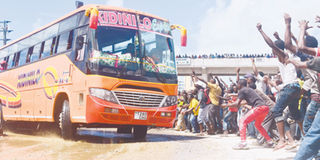Road transport: Staying alive on the highway bus

In a bid to curb road accidents, the Surface and Marine Transport Regulatory Authority (Sumatra) said it planned to install a vehicle tracking system in buses that ply upcountry routes. Now the monitoring systems are finally on the way to implementation.
PHOTOSI FILE.
What you need to know:
- The twenty-hour bus drive to Dar es Salaam had just started. A few kilometres outside Kigoma the passengers started to complain and commented that the driver “did not know how to drive normally”. After that the speed decreased slightly as the morning light came.
The bus had barely left the bus terminal in Kigoma before the driver curved it around a corner in high speed, and it felt like the right side tires were lifted from the ground. A repressed whimper rose from the passengers while luggage fell down from the compartments above them. They didn’t pay attention to the bags. Everyone had their eyes fixed on the front window and the road ahead of them. The motor uttered a roaring sound as the bus increased its speed and wobbled from side to side through the darkness of early morning.
The twenty-hour bus drive to Dar es Salaam had just started. A few kilometres outside Kigoma the passengers started to complain and commented that the driver “did not know how to drive normally”. After that the speed decreased slightly as the morning light came.
On board the bus was Happy Johnny who travelled from a family visit in Kigoma to her home in Dar es Salaam. The 27-year-old woman knew that travelling by bus was risky, and the incautious driving scared her. “The speed was dangerous. That is the problem with taking the bus, it can be dangerous,” she said.
But the bus is also affordable and convenient, Happy explained. A bus journey from Kigoma to Dar costs Sh60,000 and it is around a quarter of the price of a plane ticket. The train is affordable too, but it will take her three days to reach Dar es Salaam, she explained. If she could, she would prefer to travel by air.
“If planes were cheaper, I would take them,” Happy said.
Deadly roads
Buses are the preferred means of transport to Tanzanians who wish to cut across the country to visit relatives or to work, but the upcountry buses are often involved in accidents. Last month two buses from the same company hit each other and crashed in Manyoni District and left 31 people dead.
This happened just a few days after a bus heading to Mwanza from Dar es Salaam crashed into boulders placed on the road and killed five while leaving 13 others injured. Another accident around the same time occurred along the Morogoro-Dodoma highway where a bus driver lost control of his bus due to its speed and it overturned. Five people died and 27 others were injured.
Joseph Mussa, 68, lives in Moshi and has been a regular user of upcountry buses for decades. He thinks certain routes are more prone to high speed and reckless driving than others.
“To the north the buses are comfortable and the drivers are customer friendly, but to the lake zone buses are over-speeding and they treat passengers like cattle,” Joseph said when The Citizen met him on a bus from Arusha to Dar es Salaam. While the bus drove through the lush landscapes near Lushoto, Joseph sat calmly by the window and read his book, but his bus experiences were not always this peaceful.
Once he was travelling from Shinyanga to Mwanza by bus and the driver pushed the bus forward with raging speed without breaking when they approached a speed bump. He drove right over it. Joseph was carrying a pistol with him and he went up to the driver, pointed the pistol at him and told him to either slow down or drive straight to the nearest police station. The driver slowed down and Joseph reached Mwanza in one piece. Today he finds it hard to believe that the accidents still occur in such a large scale.
“It should not be the passengers who are responsible for their safety, but the traffic police to secure that things are calm. There should not be accidents that can be avoided. We are paying these traffic police to do their job, but they are not doing their job,” Joseph said.
In November last year the Surface and Marine Transport Regulatory Authority (Sumatra) said that it planned to install a vehicle tracking system in buses that ply upcountry routes. Now the monitoring systems are finally on the way to implementation, Director of Road Transport Regulation at Sumatra, Mr Johansen Kahatano, emphasised in an interview with The Citizen. Mr Kahatano explained that Sumatra is negotiating the contract with an international service provider of the tracking system, and he expects the vehicle trackers to be installed in all upcountry buses beginning by September this year.
“It will look like a mobile phone device. If the speed will exceed 80 kmh there will be given an alarm to the central system. So if there’s a bus near Morogoro which is over-speeding, the police in Morogoro will be ready to take action,” Mr. Kahatano said.
He estimated that the implementation of the system could take a couple of months, and should be completed by November this year. The bus companies should pay for the tracking device themselves, and if they are not able to do so, they will lose their license, Mr Kahatano explained.
Train takes time
Back in the bus from Kigoma to Dar es Salaam, Deodatus Mathias Chagga, 55, had the view over the road and the changing landscapes from his seat in the front. He travelled from Kigoma to Morogoro after having attended his brother’s funeral. He only uses the bus in the case of an emergency when he can’t plan in advance. The bus trip is easy to book, but incidents on the road make Deodatus fully aware of how dangerous it is.
“These guys are normally in a hurry, and speeding is what causes the accidents,” he said.
He wished he could always take the train and watch the hills from a safe seat. For now he doesn’t have several days to spend on the train, but if the service improves he will be pleased.
“Train is the best and the safest. It is cheap and if there is the infrastructure for it, it is going to be good,” Deodatus said as the bus had reached the wide stretches of land near Dodoma and the hills of rocks in a dry landscape. The tarmac provided an even and fast track for the bus, and it looked like the landscapes flew past the bus.
During the first hours of the travel, between Kigoma and Tabora, the bus had cut through large forests on uneven dirt roads. The speed with which the bus moved on the dirt road made the passengers bounce up and down in their seats, with the risk of being hit by a bag from the luggage compartment. The roads nearer Morogoro were less uneven, but it also meant that the driver could increase the speed.
Jacob Nicodem, a 24-year-old student of civil engineering in Dar es Salaam travelled from a family visit in Morogoro back to the commercial capital. He felt at ease with using upcountry buses, he explained and noted that when he travelled by bus as a child, the driving used to be more reckless. Back then he enjoyed to take the speediest bus of them all.
“As a child I used to take the speediest bus from Morogoro to Dar es Salaam, and I would sit in front with the driver to see how he would overtake and avoid the oncoming buses. I did it because it was similar to the video games I played. But I don’t do it anymore,” Jacob said as the bus reached the outskirts of Dar es Salaam city.
Email: [email protected]




